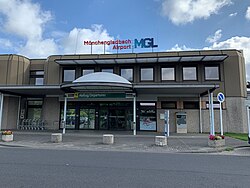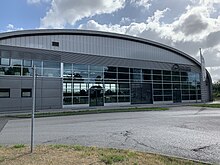Mönchengladbach airfield
| Mönchengladbach airfield | |
|---|---|

|
|
| Characteristics | |
| ICAO code | EDLN |
| IATA code | MGL |
| Coordinates | |
| Height above MSL | 38 m (125 ft ) |
| Transport links | |
| Distance from the city center | 6 km northeast of Mönchengladbach |
| Street | A44 (AS MG-Ost) / A52 (AS MG-Neuwerk) |
| Local transport | Bus line 025 |
| Basic data | |
| opening | 1955 |
| operator | Airport company Mönchengladbach GmbH |
| Passengers | 31,273 (2006) |
| Flight movements |
42,093 (2015) |
| Capacity ( PAX per year) |
600,000 passengers |
| Start-and runway | |
| 13/31 | 1200 m × 30 m asphalt |
| website | |
| https://www.mgl.de/index.php | |
The airport Moenchengladbach is a German airfield in the northeastern city of Moenchengladbach .
Airfield facility
The runway is too short for charter traffic. In emergencies, however, small and medium-sized airliners (up to Airbus A320 / Boeing 737) could land safely.
The runway is approved in both directions for all-weather flight operations level CAT I approaches. Air traffic control services are carried out by DFS Aviation Services during business hours.
The image of the airfield is primarily shaped by general aviation and by company air traffic for the maintenance companies located there.
operator
The airport has been operated by the Mönchengladbach GmbH airport company since 1956. 54.75% of this is owned by EWMG-Entwicklungsgesellschaft der Stadt Mönchengladbach mbH, 25.24% by NEW mobil und aktiv Mönchengladbach , 20% by Flughafen Düsseldorf GmbH and 0.01% by the city of Willich .
Before that, Flughafen Düsseldorf GmbH was the majority shareholder with 70.03%. In May 2018, however, the city council of Mönchengladbach decided to acquire shares from the operating company of Düsseldorf Airport, so that the share was reduced from 70.03% to 20%.
In addition, five maintenance companies are represented in MGL and form an important location for aircraft maintenance. Business aviation accounts for the largest share.
In addition, four flight schools and an association in MGL offer the opportunity to acquire a pilot's license, which strengthens general aviation in Mönchengladbach.
history
Today's airfield is already Mönchengladbach's second airfield. The first airfield was in the west of the city until 1945. The north park is located here today.
After 1945, the area of the airfield was used as a waste collection point and rubble depository. When grass had grown over it, a model airfield and a parachute jump area were built with a lot of visitors on the weekends. The Mönchengladbach glider airfield was built in 1955 as a small glider airfield with only one grass runway. Two years later a hangar was built, and the following year a tower and a passenger building were built. The construction of the 1200-meter-long runway, which still exists today, began in 1970 and was completed in 1973.
In 1993/1994 Flughafen Düsseldorf GmbH took over 70 percent of Mönchengladbach Airport Company with the intention of relocating regional air traffic from Düsseldorf Airport to Mönchengladbach. Scheduled air traffic was opened on April 1, 1996. The airfield initially became an important alternative airport due to the consequences of the severe fire that broke out ten days later at Düsseldorf Airport and in 1998 had 224,000 passengers. In the years that followed, however, bankruptcies and airline churn led to a significant decline.
From April 1996 to February 2003 the Belgian airline VLM Airlines offered flights between Mönchengladbach (Düsseldorf Express Airport Mönchengladbach MGL) and London City. Were used while turboprop aircraft of the type Fokker 50s . From 1999 VLM could also reach the Channel Islands via London . On March 1, 2003 the connection was discontinued. The British airline Debonair also operated scheduled flights to London-Luton, Barcelona, Madrid, Rome and Munich during this period. From March 1 to October 31, 2003, Air Berlin also flew from Mönchengladbach to Bergamo, London-Stansted, Zurich and Vienna.
On February 5, 2007, the newly founded Austrian airline Smartline began its flight operations. The connection to St. Gallen was offered twice a day. However, flight operations were suspended again in March due to an apparent lack of demand. Most recently another company flew to Usedom once a week during the summer months . Since the departure of the airline GLOBUS , which used an ATR 42 to fly to Heringsdorf on Usedom and Katowice in Poland, there has been no more scheduled air traffic. Since then, sightseeing flights over the Mönchengladbach region to the north of Düsseldorf have occasionally been offered. In addition, the forecourt of the airfield serves as the main bus stop for a local coach operator, from where larger bus trips start and end.
Pros and cons
Many critics see the airfield as superfluous. They are based on the argument that in North Rhine-Westphalia u. a. With Düsseldorf Airport , Cologne / Bonn Airport and Niederrhein Airport , a more than sufficient amount of aeronautical infrastructure is already in place. Supporters, on the other hand, are of the opinion that the airfield could represent an important relief for Düsseldorf Airport and see it primarily as a regional airport, which should score with short distances, fast handling and its clarity. In addition, as an argument in favor of the airport's viability, Air Berlin met with lively customer interest with its scheduled flights from Mönchengladbach, but nevertheless withdrew because the BAe 146 aircraft used were not profitable enough from their point of view and the operation more economical machines because of the short runway is not possible. In addition, more jobs are to be created through the settlement of companies near the airport.
future
In order to make the airfield more attractive, an application for the opening of a plan approval procedure was submitted to the state of North Rhine-Westphalia in 2003 . The aim of this application was to extend the runway to 2,320 meters and to build a new terminal designed for 3 million passengers per year. This project failed because the regional council of the Düsseldorf administrative district decided on September 29, 2005 that a necessary change in the area development plan would not be implemented. One of the reasons: The Mönchengladbach airfield is in the traffic shadow of Düsseldorf International Airport. This severely affects its development. The Mönchengladbach airfield had to experience in recent years how this traffic shadow affects. From 180,000 passengers per year (arrival and departure are counted) the number of passengers fell to the current 31,000 per year.
On May 23, 2007 the responsible minister for building and transport Wittke declared in the Düsseldorf state parliament that due to the rejection of the area development plan by the regional council (see above) and the lack of backing from the state air transport concept, there will be no expansion of the VLP MGL. In the regional press this was described as an impending end to the airfield.
In December 2009, the Düsseldorf airport company announced that it would not expand the Mönchengladbach airfield in the future. The airport is to continue to operate, but no final decision has yet been made about the measures to reduce costs. The Düsseldorf airport company decided in June 2010 that it would continue to pay for the costs of the airfield. Savings are to be achieved by shortening the operating times and by excluding scheduled and charter traffic.
In September 2019 it became known that the development company of the city of Mönchengladbach (EWMG) had terminated the lease for the nearby trotting track at the end of December 2021 in favor of the airport expansion.
Exhibition and events
The Hugo Junkers hangar on the site of the Mönchengladbach airfield has been used as a venue for events and exhibitions, for conferences, company parties, etc. used. In addition, a "Fly and Drive In" takes place every last Sunday from May to September. On these days, flying and moving historic old-timers, from double-deckers to motor vehicles to bicycles, meet on the apron of the hangar with free entry for visitors. The focus is on the Ju 52 , HB-HOY stationed in Mönchengladbach , which is at home in the hangar but is currently not airworthy. Sightseeing flights with some historical aircraft are also possible on these days.
Web links
- Official website of the airport
- Photo album and history of the airport
- Website of the Förderverein Flughafen Mönchengladbach e. V.
- Website of the citizens' groups in Airpeace
- Information on planning approval
- Hugo Junkers hangar
Individual evidence
- ^ General Aviation. MGL.de, accessed on March 18, 2017 .
- ↑ Airport in Mönchengladbacher Hand Report in the daily newspaper Rheinische Post on May 17, 2018, accessed on May 21, 2018
- ↑ Jan Schnettler: “When Gladbach quickly became a hub”. Rheinische Post, September 26, 2014, accessed on March 9, 2017 .
- ↑ Peter Korall et al. Werner Dohmen: "This is a victory for all Willich citizens". Westdeutsche Zeitung, September 30, 2005, archived from the original on September 26, 2007 ; Retrieved May 1, 2013 .
- ^ Minutes of the plenary session of the 61st session of the 14th period. State Parliament of North Rhine-Westphalia, May 23, 2007, accessed on May 1, 2013 (page 6882).
- ↑ Thomas Reisener: Mönchengladbach Airport is threatened. Rheinische Post, May 17, 2007, accessed on May 1, 2013 .
- ↑ Ralf Jüngermann: The end of the airfield. (No longer available online.) Rheinische Post, December 18, 2009, archived from the original on February 2, 2017 ; Retrieved May 1, 2013 . Info: The archive link was inserted automatically and has not yet been checked. Please check the original and archive link according to the instructions and then remove this notice.
- ↑ Ralf Jüngermann: The airport remains - the city pays nothing. Rheinische Post, June 25, 2010, archived from the original on October 23, 2010 ; Retrieved May 1, 2013 .
- ↑ Gabi Peters: Lease contract Trabrennbahn is terminated. In: rp-online.de . September 24, 2019, accessed September 24, 2019 .
